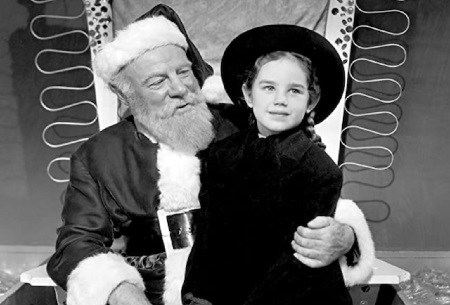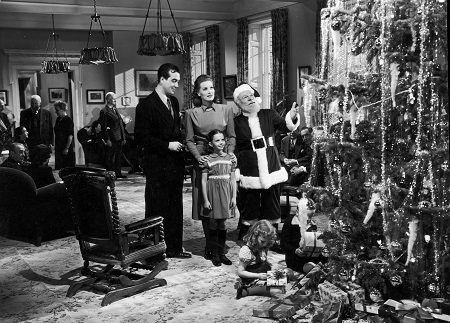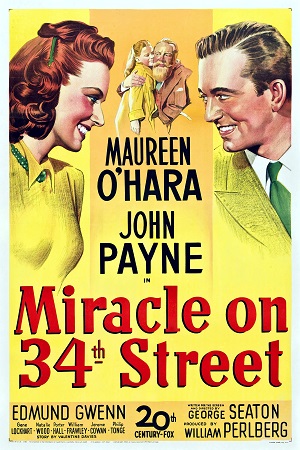
Unforgettables: Cinematic Milestones #11 – Miracle on 34th Street (1947)
by Sara Michelle Fetters - December 21st, 2022 - Features
I believe in Santa Claus: Unwrapping the magical pleasures of Miracle on 34th Street on its 75th anniversary
NOTE: This feature originally appeared in the December 2, 2022 edition of the Seattle Gay News. It is reprinted here by permission of the publisher Angela Craigin.
In 1947’s Miracle on the 34th Street, a film overflowing with memorable moments, there is one that stands out above the rest. Disbelieving youngster Susan Walker (Natalie Wood) is secretly spying on Macy’s current Santa Claus (Edmund Gwenn, in an Academy Award–winning performance) — who defiantly insists his name actually is Kris Kringle — as he speaks to scared little war orphan in her native Dutch. The latter blossoms into a state of pure, unfettered joy, even getting to sing a holiday carol with the man she lovingly calls “Sinterklaas.”
Much like the “La Marseillaise” scene in 1942’s Casablanca, this small musical moment is a guaranteed crowd-pleaser that doesn’t leave a single dry eye to be found. But it also hints at the larger themes at play in director George Seaton’s spellbinding comedic drama: Belief. Hope. Kindness. Empathy. Understanding. Faith. Love. All are central factors in how this gem has managed to maintain its status as a beloved classic for three-quarters of a century.
The plot is familiar to even those who’ve never even watched this black-and-white treasure. Jolly Kris Kringle, worried about the state of Christmas and how it has been commercialized, journeys to New York City to get a firsthand look at what’s going on in the world. Through a series of fortunate events, he ends up being hired by Doris Walker (Maureen O’Hara) to become Macy’s new Santa Claus. She’s lost the Christmas spirit and has passed those beliefs to her daughter Susan. Kris decides he’s going to prove to the duo what the holiday is all about.
There’s plenty more added to the mix, including Doris’s charming next-door neighbor Fred Gailey (John Payne), a lawyer smitten with the single mother. At Macy’s, there’s the head of the toy department, Julian Shellhammer (Philip Tonge), who views Kris’s arrival as a gift from the heavens. On the opposite side is store psychologist Granville Sawyer (Porter Hall), who recommends that the new Santa be immediately dismissed for being psychologically unbalanced.
Other memorable characters pop in and out, and everything culminates in a sanity hearing, where Kris is put on trial and Fred must prove this lovable old man truly is the one, true Santa Claus. It’s as goofy as it sounds. But all the comedic beats are so natural, the emotions so authentic, and the overall dramatic conflict so genuine — who cares how silly it all is? Seaton and his talented cast make the audience believe there really is a Santa Claus, and I don’t think any other film has ever managed to do likewise with an ounce of the same effortless grace.
I was lucky. The first time I saw Miracle on 34th Street was during a winter children’s film festival at a local Spokane theater. It was showing Willy Wonka and the Chocolate Factory, The Wizard of Oz, White Christmas, and a handful of other titles. But this is the one my mom insisted we go see, and I have been forever thankful she put her holiday-season foot down.
It probably had something to do with her love of the annual Macy’s Thanksgiving Day Parade. Or maybe this was a film she watched with her own mother, and so she wanted to share it with me. I honestly do not know; for whatever reason, I’ve never thought to ask. All I do know is that, much like annual viewings of Holiday Inn and Lady and the Tramp (it’s a Christmas movie, trust me on that), this one has become a December staple in our household, and deservedly so.
For me, I think it may be how forward-thinking so much of it is, and how ahead of its time many of its core elements are. Seaton takes author Valentine Davies’ source material, and instead of minimizing some of its socially cantankerous elements, he emphasizes them. He pulls no punches about Doris being a divorced single mother working in a position of power at a major New York department store. He allows Susan to be an intelligent, constantly questioning youngster who isn’t afraid to speak truth to power or ask difficult questions as she thirsts for knowledge.
The truth is that there is no other film quite like Miracle on 34th Street. The 1994 remake couldn’t recapture the original’s magic, and there’s never been any subsequent cinematic depiction of Santa Claus that equals what Gwenn does here. But as marvelous as all of that is, I think what has allowed Seaton’s film to endure is that Doris and Susan are this story’s primary players, and the director asks the viewer to see things from their point of view, no matter their gender or background.
Just before the trial is set to begin, Fred empathically tells Doris, “Faith is believing things when common sense tells you not to. Don’t you see? It’s not just Kris that’s on trial. It’s everything he stands for. It’s kindness and joy and love and all the other intangibles.” It’s a melodramatic statement, and one that should have drowned the film in saccharine and treacle as it built to its fantastical post office department conclusion.
But that is not the case. The film allows Doris to mull those words with introspective sincerity. She does not dismiss them. She equally does not come to embrace them arbitrarily. Doris must find the truth in those words for herself and, subsequently explain her reasoning to Susan in her own way.
Because of this, Miracle on 34th Street is the gift that keeps on giving. Here’s hoping audiences continue to unwrap its many pleasures for another 75 years.
Now celebrating its 75th anniversary, Miracle on 34th Street is available on Blu-ray and DVD and to purchase digitally on multiple platforms. It is also currently streaming on Disney+.






